Charles E W Bean, Diaries, AWM38 3DRL 606/1/1 - October - December 1914 - Part 6
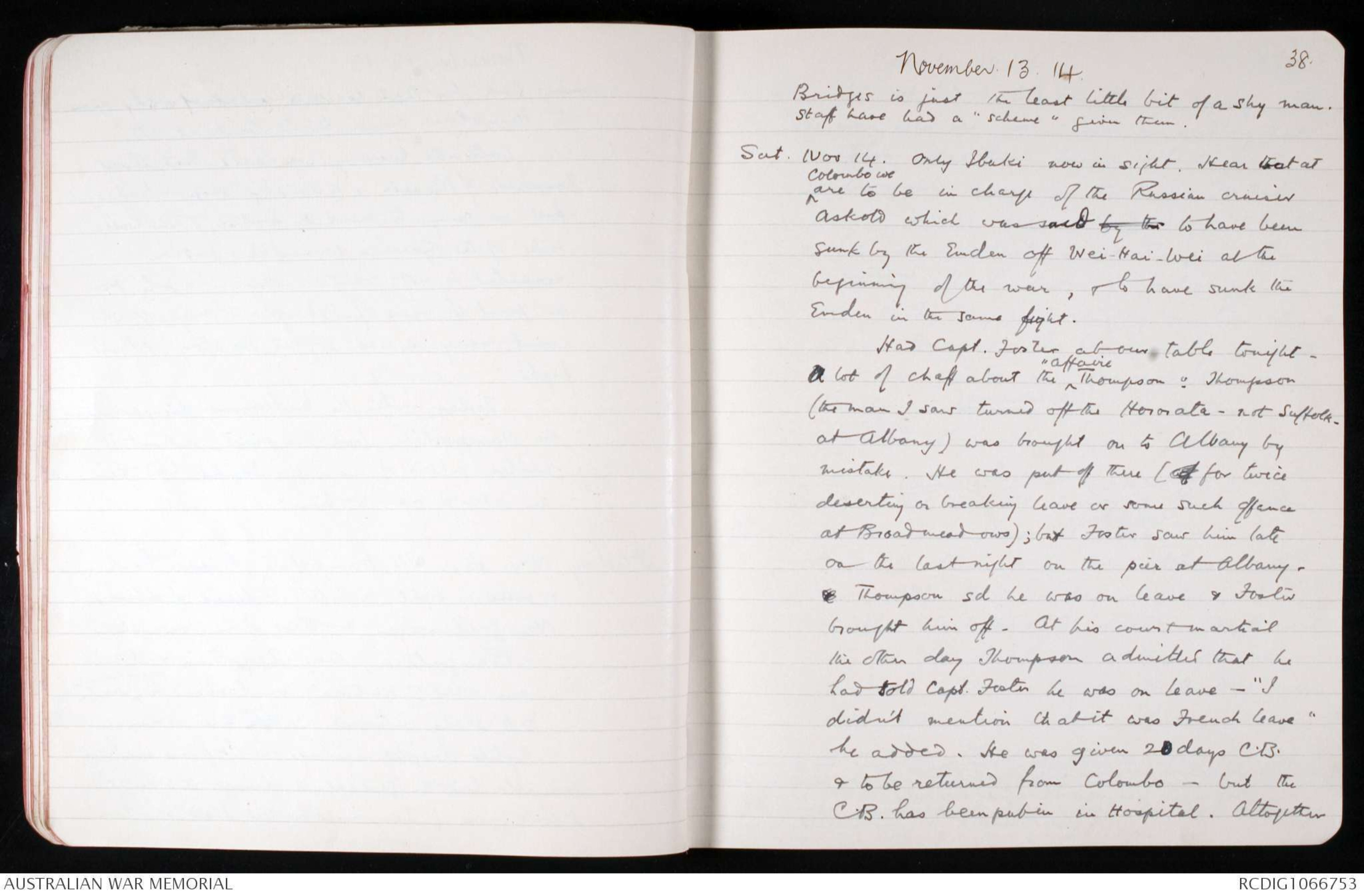
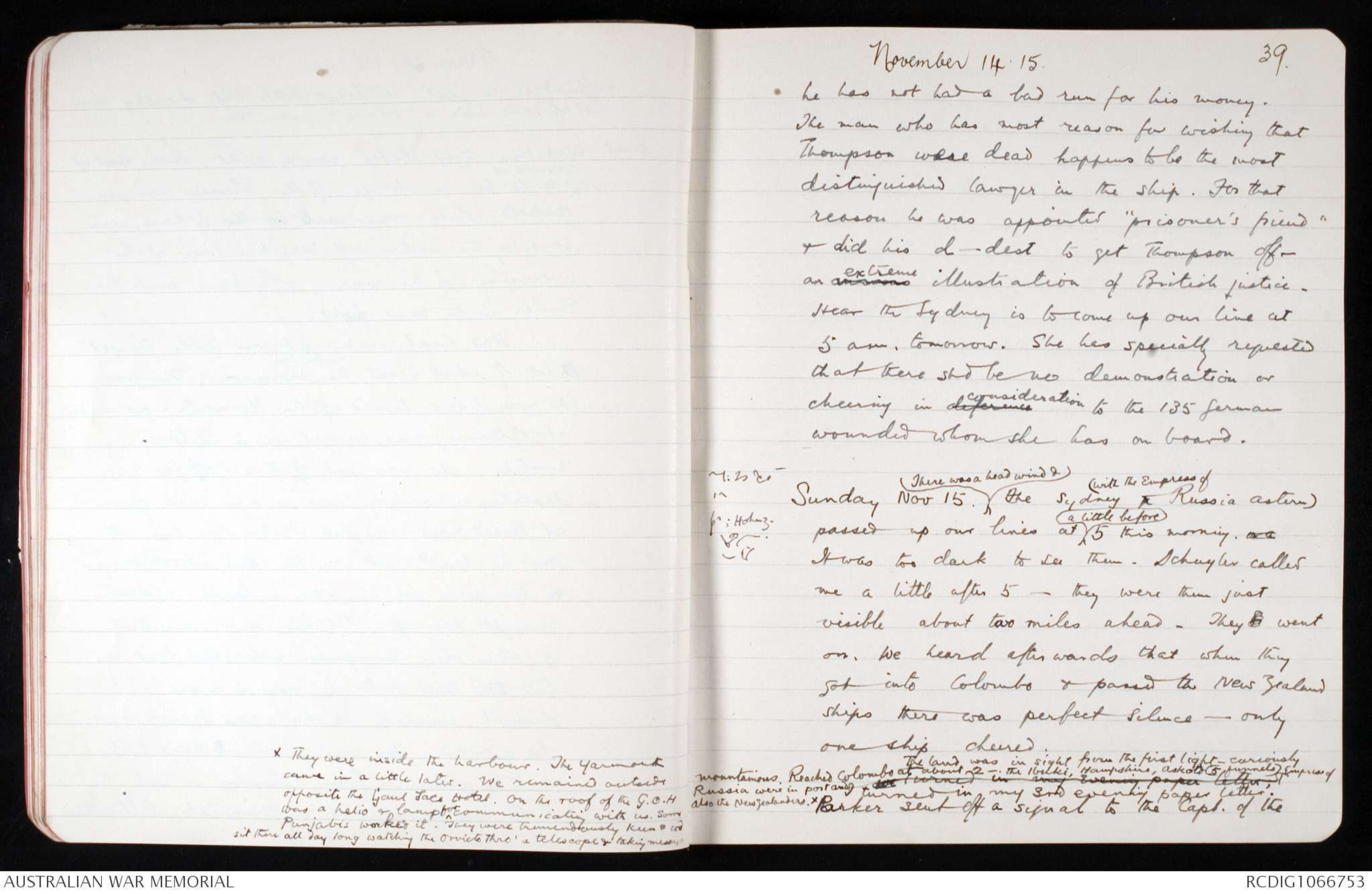
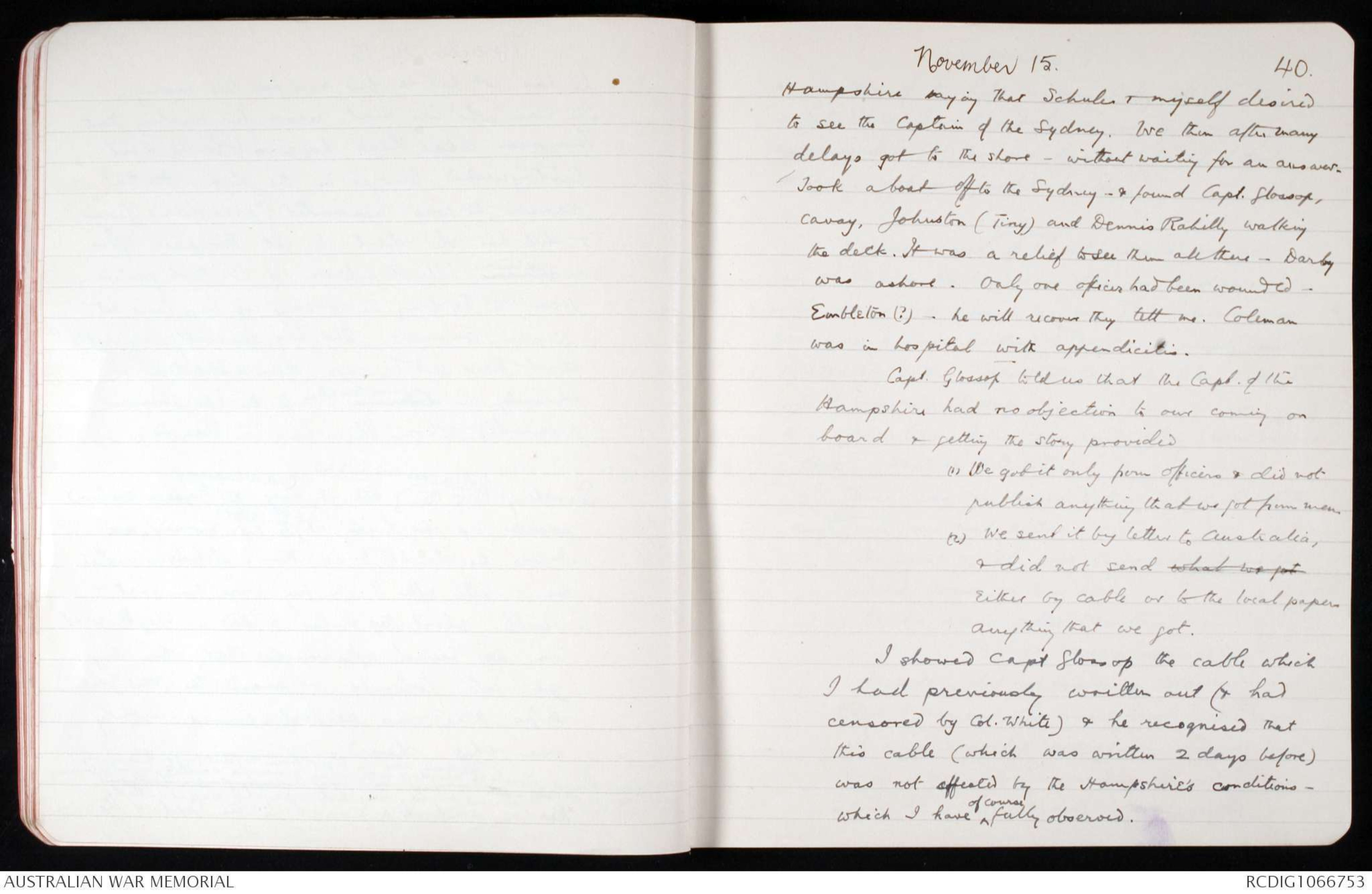
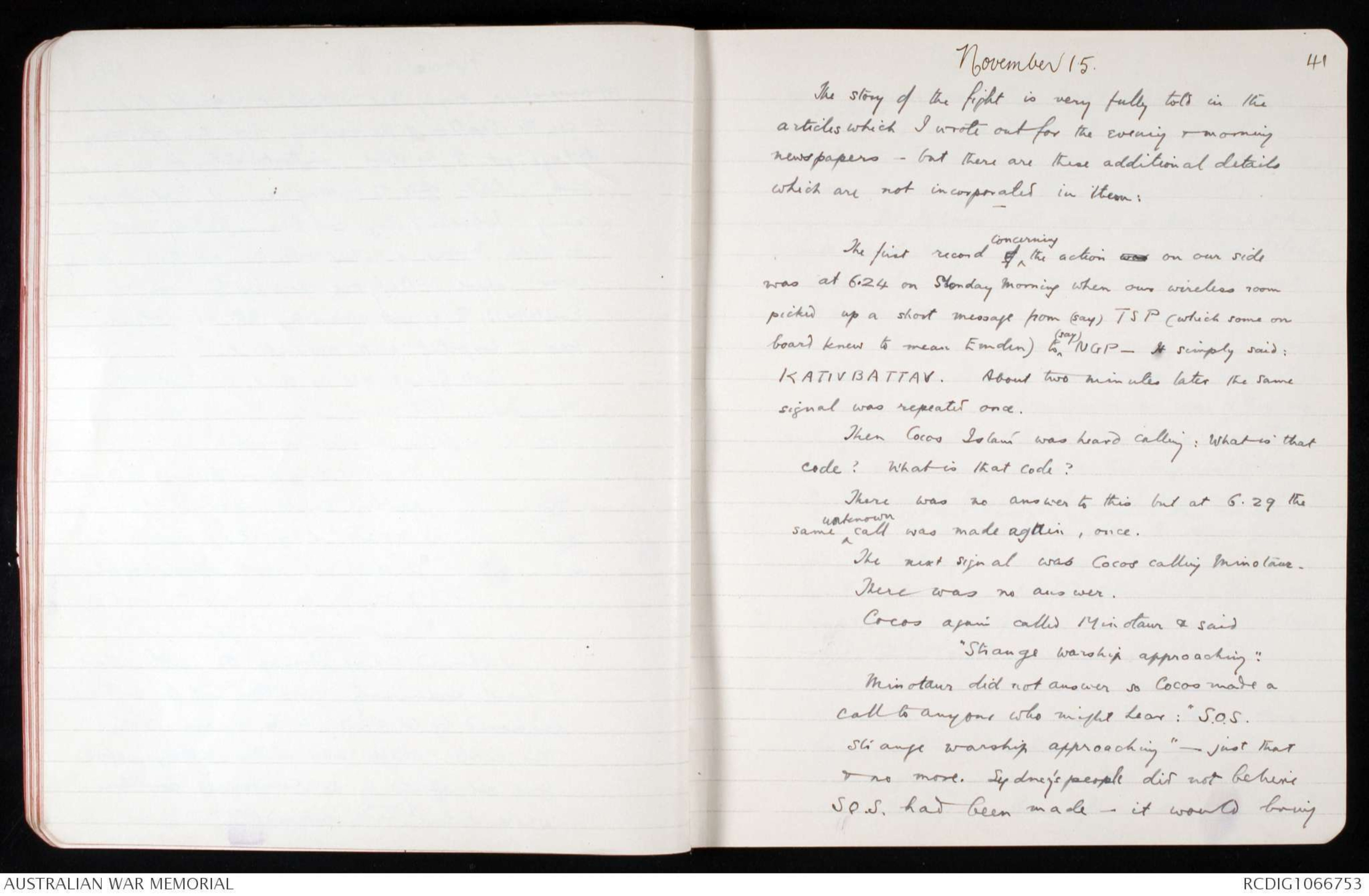
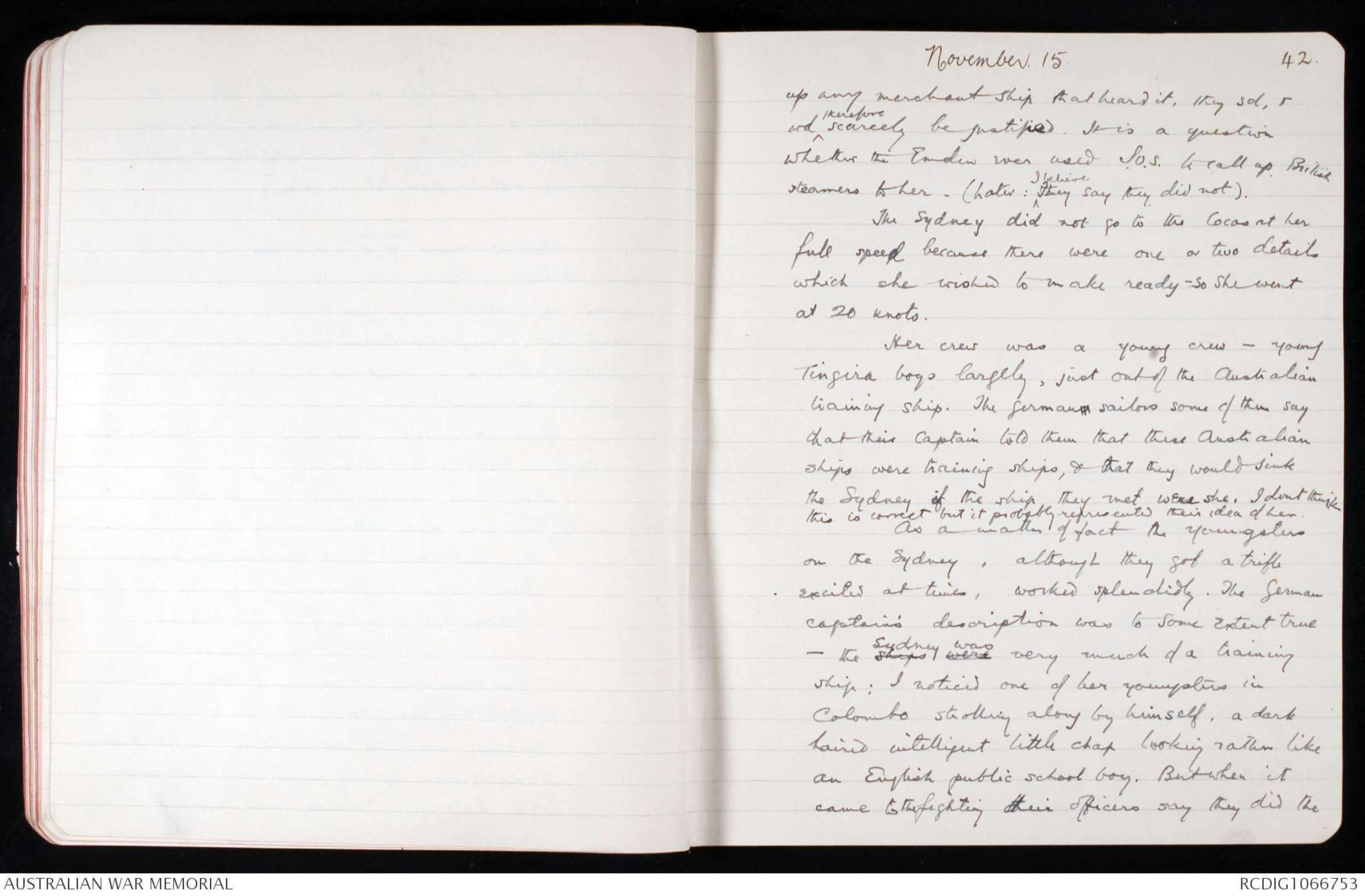
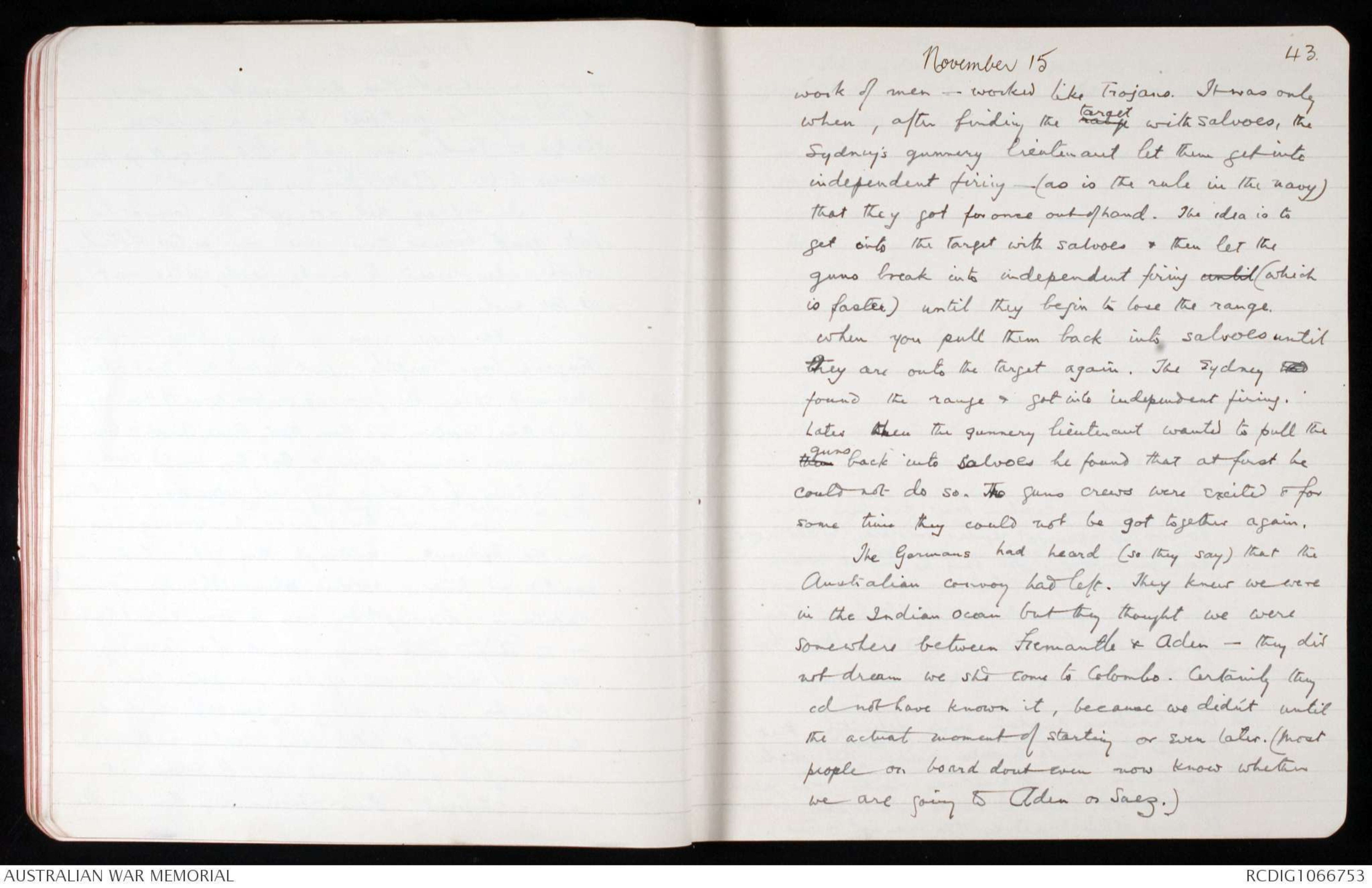
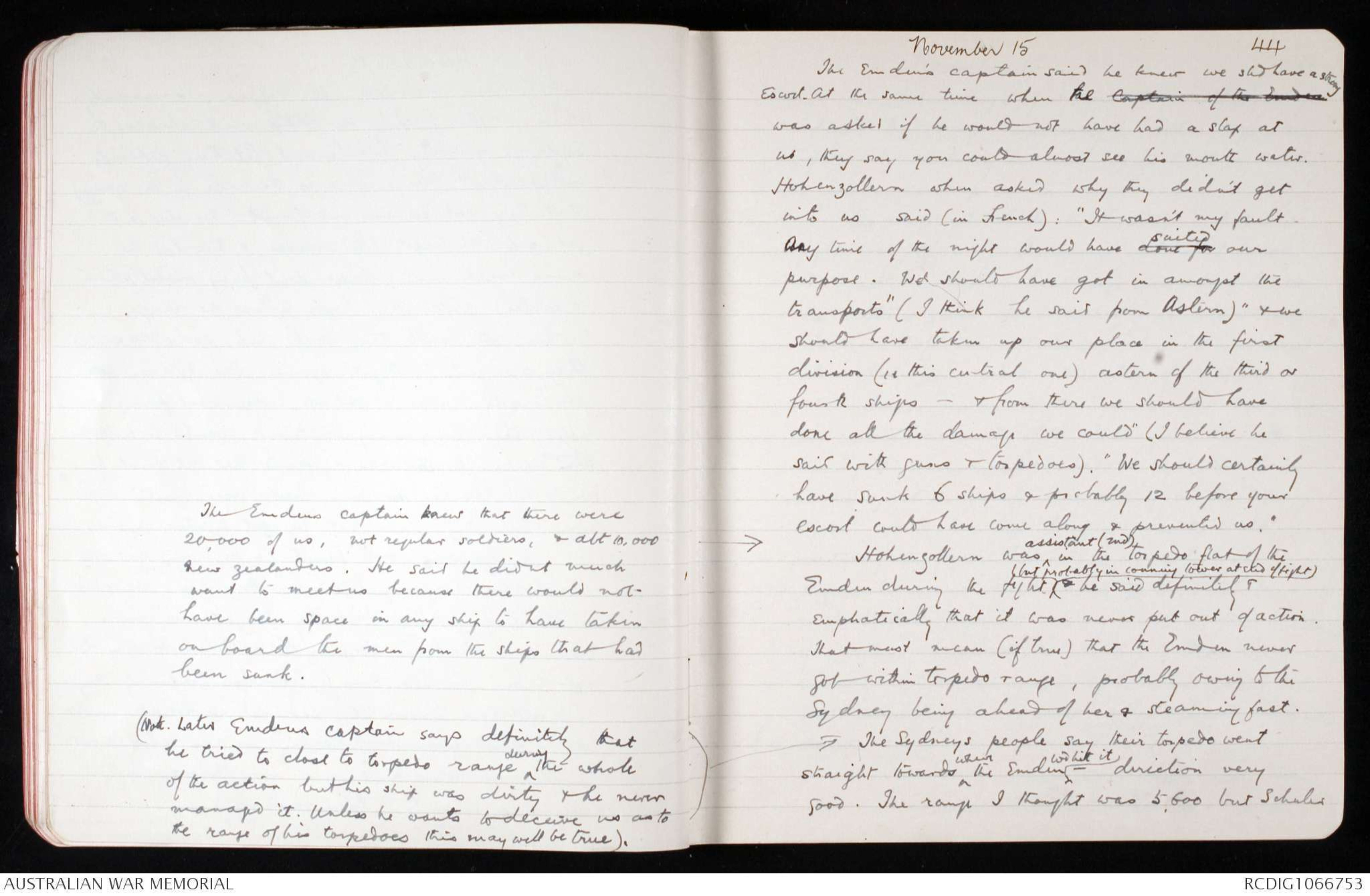
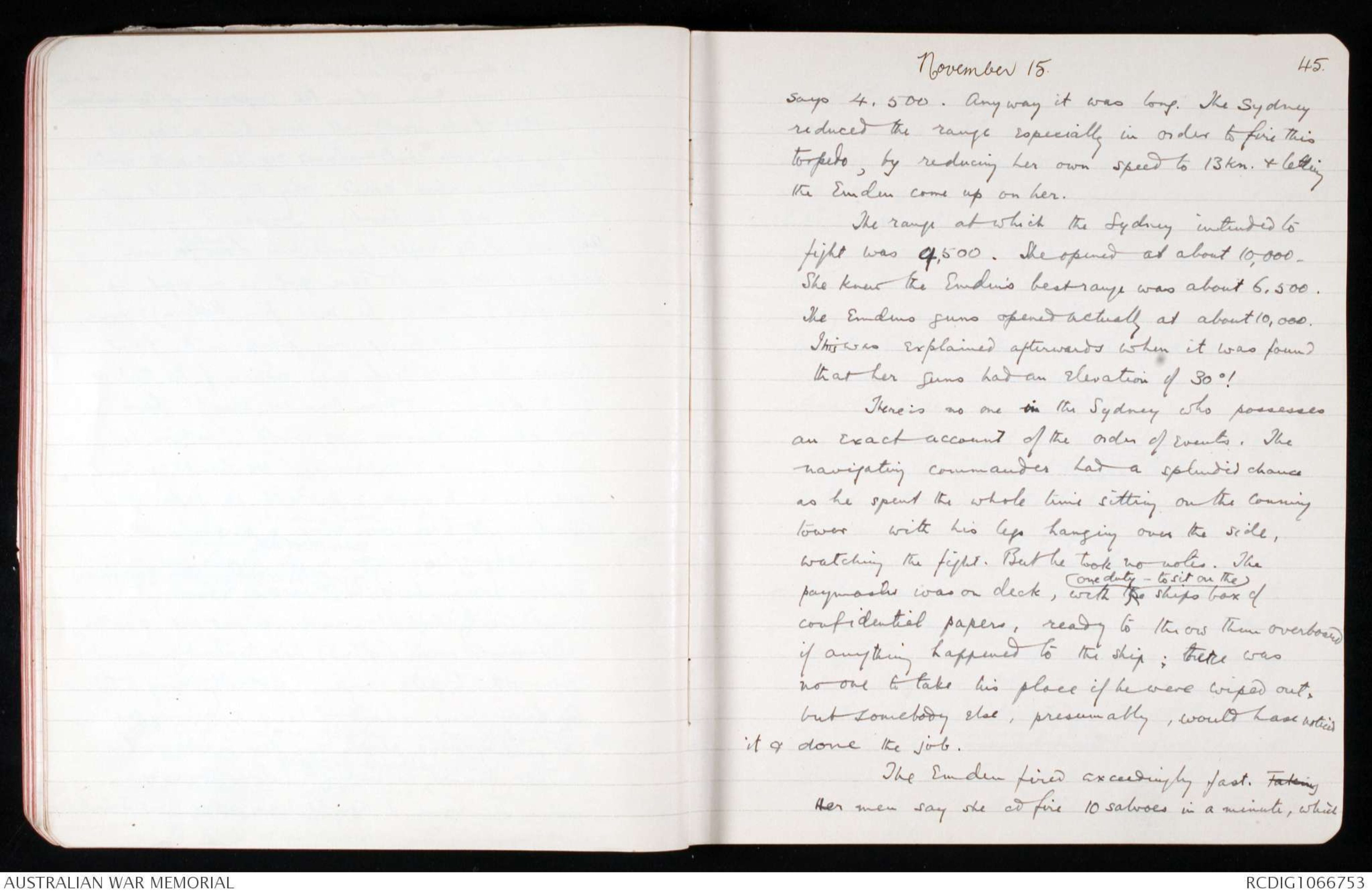
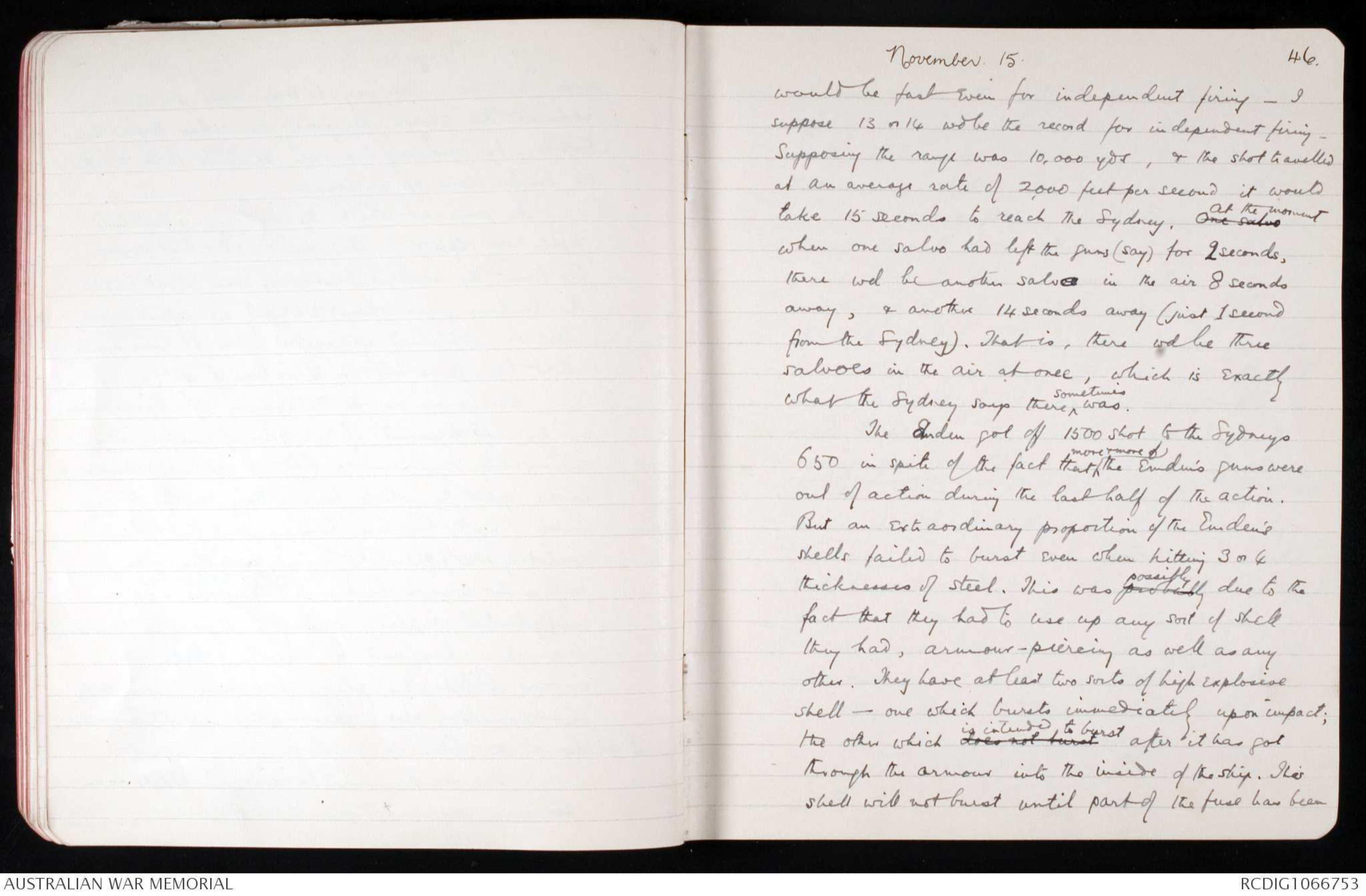
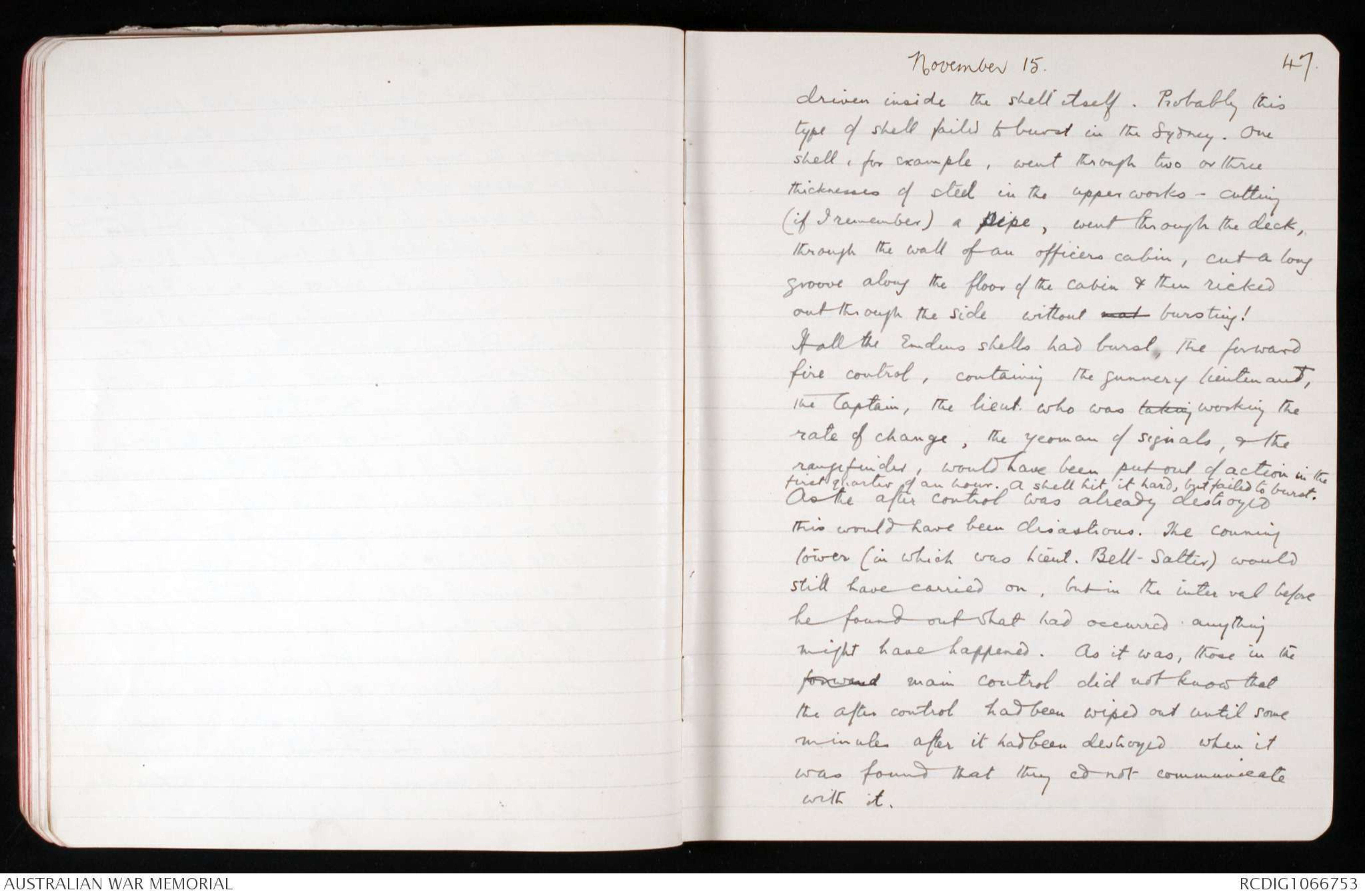
38.
November. 13. 14.
Bridges is just the least little bit of a shy man.
Staff have had a "scheme" given them.
Sat. Nov 14. Only Ibuki now in sight. Hear that at
^ Colombo we are to be in charge of the Russian cruiser
Askold which was said by the to have been
sunk by the Emden off Wei-Hai-Wei at the
beginning of the war, & to have sunk the
Emden in the same fight.
Had Capt. Foster at our table tonight.
A lot of chaff about the "Affaire Thompson". Thompson
(the man I saw turned off the Hororata - not Suffolk -
at Albany) was brought on to Albany by
mistake. He was put off there (af for twice
deserting or breaking leave or some such offence
at Broadmeadows); but Foster saw him late
on the last night on the pier at Albany.x Thompson sd he was on leave & Foster
brought him off. At his court martial
the other day Thompson admitted that he
had told Capt. Foster he was on leave – "I
didn't mention that it was French leave"
he added. He was given 20 days C.B.
& to be returned from Colombo - but the
C.B. has been put in in Hospital. Altogether
X They were inside the harbour. The Yarmouth
came in a little later. We remained outside
opposite the Gaul Face Hotel. On the roof of the G.O.H.
was a helio & lamp ^ for communicating with us. Some
Punjabis worked it. They were tremendously keen & cod
sit there all day long watching the Orvieto thro' a telescope & taking messages
39.
November 14.15.
he has not had a bad run for his money.
The man who has most reason for wishing that
Thompson were dead happens to be the most
distinguished lawyer in the ship. For that
reason he was appointed "prisoner's friend"
& did his d-dest to get Thompson off -
an anxxxx extreme illustration of British justice.
Hear the Sydney is to come up our line at
5 am. tomorrow. She has specially requested
that there shd be no demonstration or
cheering in deference consideration to the 135 German
wounded whom she has on board.
Sunday Nov 15. ^ There was a head wind & the Sydney ^ with the Empress of Russia astern)
passed up our lines at ^ a little before 5 this morning. on a
It was too dark to see them. Schuyler called
me a little after 5 - they were then just
visible about two miles ahead. They f went
on. We heard afterwards that when they
got into Colombo & passed the New Zealand
ships there was perfect silence - only
one ship cheered.
The land was in sight from the first light - curiously
mountainous. Reached Colombo at about 2 - the Ibuki, Hampshire, Askold (5 funnels) Empress of
Russia were in port and
also the New Zealanders.x we turned in my evening paper letter,
I turned in my 3rd evening paper letter.
Parker sent off a signal to the Capt. of the
[*Shorthand in margin - see original note*]
November 15.
40.
Hampshire saying that Schuler & myself desired
to see the Captain of the Sydney. We then after many
delays got to the shore - without waiting for an answer.
Took a boat off to the Sydney - & found Capt. Glossop,
Cavay, Johnston (Tiny) and Dennis Rahilly walking
the deck. It was a relief to see them all there - Darby
was ashore. Only one officer had been wounded -
Embleton (?) – he will recover they tell me. Coleman
was in hospital with appendicitis.
Capt. Glossop told us that the Capt. of the
Hampshire had no objection to our coming on
board & getting the story provided
(1) We got it only from officers & did not
publish anything that we got from men
(2) We sent it by letter to Australia,
& did not send what we got
either by cable or to the local papers
anything that we got.
I showed Capt Glossop the cable which
I had previously written out (& had
censored by Col. White) & he recognised that
this cable (which was written 2 days before)
was not affected by the Hampshire's conditions -
which I have ^ of course fully observed.
41
November 15.
The story of the fight is very fully told in the
articles which I wrote out for the evening & morning
newspapers - but there are these additional details
which are not incorporated in them:
The first record of ^ concerning the action was on our side
was at 6.24 on Monday morning when our wireless room
picked up a short message from (say) TSP (which some on
board knew to mean Emden) to ^ (say) NGP – It simply said:
KATIVBATTAV. About two minutes later the same
signal was repeated once.
Then Cocos Island was heard calling: What is that
code? What is that code?
There was no answer to this but at 6.29 the
same ^ unknown call was made again, once.
The next signal was Cocos calling Minotaur.
There was no answer.
Cocos again called Minotaur & said
"Strange warship approaching".
Minotaur did not answer so Cocos made a
call to anyone who might hear: "S.O.S.
strange warship approaching" - just that
& no more. Sydney's people did not believe
S.O.S. had been made - it would bring
42.
November. 15.
up any merchant ship that heard it, they sd, &
wd ^ therefore scarcely be justified. It is a question
whether the Emden ever used S.O.S. to call up British
steamers to her. (Later: ^ I believe they say they did not).
The Sydney did not go to the Cocos at her
full speed because there were one or two details
which she wished to make ready - so she went
at 20 knots.
Her crew was a young crew - young
Tingira boys largely, just out of the Australian
training ship. The germans sailors some of them say
that their Captain told them that these Australian
ships were training ships, & that they would sink
the Sydney if the ship they met were she. I don't think
this is correct but it probably represented their idea of her.
As a matter of fact the youngsters
on the Sydney, although they got a trifle
excited at times, worked splendidly. The German
captain's description was to some extent true
- the ships were Sydney was very much of a training
ship; I noticed one of her youngsters in
Colombo strolling along by himself, a dark
haired intelligent little chap looking rather like
an English public school boy. But when it
came to the fighting their officers say they did the
43.
November 13
work of men - worked like Trojans. It was only
when, after finding the targe target with salvoes, the
Sydney's gunnery lieutenant let them get into
independent firing - (as is the rule in the navy)
that they got for once out of hand. The idea is to
get onto the target with salvoes & then let the
guns break into independent firing until (which
is faster) until they begin to lose the range.
when you pull them back into salvoes until
they are onto the target again. The Sydney had
found the range & got into independent firing.
Later then the gunnery lieutenant wanted to pull thethem guns back into salvoes he found that at first he
could not do so. The guns crews were excited & for
some time they could not be got together again.
The Germans had heard (so they say) that the
Australian convoy had left. They knew we were
in the Indian Ocean but they thought we were
somewhere between Fremantle & Aden - they did
not dream we shd come to Colombo. Certainly they
cd not have known it, because we didn't until
the actual moment of starting or even later. (Most
people on board dont even now know whether
we are going to Aden or Suez.)
The Emdens captain knew that there were
20,000 of us, not regular soldiers, & abt 10,000
new zealanders. He said he didnt much
want to meet us because there would not
have been space in any ship to have taken
on board the men from the ships that had
been sank.
(Note. Later Emdens captain says definitely that
he tried to close to torpedo range ^ during the whole
of the action but his ship was dirty & he never
managed it. Unless he wants to deceive us as to
the range of his torpedoes this may will be true).
44
November 15
The Emden's captain said he knew we shd have a strong
Escort. At the same time when the Captain of the Emden
was asked if he would not have had a slap at
us, they say you could almost see his mouth water.
Hohenzollern when asked why they didn't get
into us said (in French): "It wasn't my fault.
Any time of the night would have done for suited our
purpose. We should have got in amongst the
transports" (I think he said from Astern)" & we
should have taken up our place in the first
division (ie this central one) astern of the third or
fourth ships - & from there we should have
done all the damage we could" (I believe he
said with guns & torpedoes). "We should certainly
have sunk 6 ships & probably 12 before your
escort could have come along & prevented us."
→ Hohenzollern was ^ assistant (2nd) in the torpedo flat of the
Emden during the fight ^ (but probably in conning tower at end of fight) & he said definitely &
emphatically that it was never put out of action.
That must mean (if true) that the Emden never
got within torpedo range, probably owing to the
Sydney being ahead of her & steaming fast.
→ The Sydneys people say their torpedo went
straight towards ^ where the Emden ^ wd hit it - direction very
good. The range I thought was 5,600 but Schuler
45.
November 15.
says 4,500. Any way it was long. The Sydney
reduced the range especially in order to fire this
torpedo, by reducing her own speed to 13km. & letting
the Emden come up on her.
The range at which the Sydney intended to
fight was 9,500. She opened at about 10,000.
She knew the Emden's best range was about 6,500.
The Emdens guns opened actually at about 10,000.
This was explained afterwards when it was found
that her guns had an elevation of 30°!
There is no one in the Sydney who possesses
an exact account of the order of events. The
navigating commander had a splendid chance
as he spent the whole time sitting on the conning
tower with his legs hanging over the side,
watching the fight. But he took no notes. The
paymaster was on deck, with ^ one duty - to sit on the the ships box of
confidential papers, ready to know throw them overboard
if anything happened to the ship; there was
no one to take his place if he were wiped out,
but somebody else, presumably, would have noticed
it & done the job.
The Emden fired exceedingly fast. Taking
Her men say she cd fire 10 salvoes in a minute, which
46.
November. 15.
would be fast even for independent firing - I
suppose 13 or 14 wd be the record for in dependent firing -
Supposing the range was 10,000 yds, & the shot travelled
at an average rate of 2,000 feet per second it would
take 15 seconds to reach the Sydney. One salvo At the moment
when one salvo had left the guns (say) for 2 seconds,
there wd be another salvoe in the air 8 seconds
away, & another 14 seconds away (just I second
from the Sydney). That is, there wd be three
salvoes in the air at once, which is exactly
what the Sydney says there ^ sometimes was.
The Emden got off 1500 shot to the Sydneys
650 in spite of the fact that ^ more & more of the Emden's guns were
out of action during the last half of the action.
But an extraordinary proportion of the Emden's
shells failed to burst even when hitting 3 or 4
thicknesses of steel. This was probably possibly due to the
fact that they had to use up any sort of shell
they had, armour-piercing as well as any
other. They have at least two sorts of high explosive
shell - one which bursts immediately upon impact;
the other which does not burst is intended to burst after it has got
through the armour into the inside of the ship. This
shell will not burst until part of the fuse has been
47.
November 15.
driven inside the shell itself. Probably this
type of shell failed to burst in the Sydney. One
shell, for example, went through two or three
thicknesses of steel in the upper works - cutting
(if I remember) a pipe, went through the deck,
through the wall of an officers cabin, cut a long
groove along the floor of the cabin & then ricked
out through the side without not bursting!
If all the Emdens shells had burst, the forward
fire control, containing the gunnery lieutenant,
the Captain, the lieut. who was taking working the
rate of change, the yeoman of signals, & the
rangefinder, would have been put out of action in the
first quarter of an hour. A shell hit it hard, but failed to burst.
As the after control was already destroyed
this would have been disastrous. The conning
tower (in which was Lieut. Bell-Salter) would
still have carried on, but in the interval before
he found out what had occurred anything
might have happened. As it was, those in theforward main control did not know that
the after control had been wiped out until some
minutes after it had been destroyed when it
was found that they cd not communicate
with it.
 Robyn G
Robyn GThis transcription item is now locked to you for editing. To release the lock either Save your changes or Cancel.
This lock will be automatically released after 60 minutes of inactivity.